
| Section: Articles |
|
||||||||
| Section: List | |||||||||
| Section: Credits | |||||||||
| Section: Links |

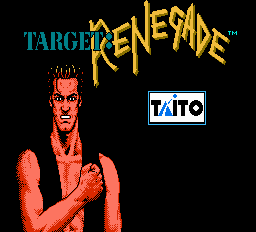
Renegade was an instant classic back in its time, and it is regarded as some to be the first of its kind. Taito's standard brand of brawling was fun and addictive, even though they didn't really do much to set themselves apart. I played Renegade a lot, so Target: Renegade immediately stood out from all the other NES carts I saw at the flea market. Bright summer days, endless isles of merchants, and endless games across tables. I remember. I chose with little hesitation and hoped it was like Renegade. Thankfully, it was. Those days are long gone, but the game would later be a tether for memories that remain. It may sound juvenile, but this old, 8-Bit, pixelated game is a tether to memories that keep me real and remind me never to forget where I'm from.

Memories fade into my conscious when I play this game. My youth flashes dimly, rusted over by subsequent misfortune. Living across the street from the flea market, in a trailer on the corner near an A-frame house that still stands today. Showing its age year after year, the A-frame still stands; physically as a sort of beacon to less-complicated times, and nostalgically as a memento that reminds me of games like Target: Renegade. That place has been around for a long time; since way back in the day when we lived in the trailer park across the street. It was there that I played Target: Renegade, and I will never forget it.
In between being locked in a dark room and being grounded for nothing, I somehow had rare chances to actually be a kid. I'd play this game when I could be a kid, but it didn't happen a lot. From my room window, I'd sit and watch the world outside go by until sundown, people carrying about their daily business. Kids playing, parents returning home from work, animals roaming, kids riding bikes; I watched them all do normal stuff that I would sometimes have the "privelage" of doing. Of course, I was only allowed to do normal things (like going outside) when my step-father wanted me out of the house so he could spend time with his "real" son and family. Other than that, I was grounded from literally everything, so I'd sit idly and daydream of playing this game. From an empty room. No, my room wasn't empty because we were that poor, he was just a bastard who had no respect for children. I remember a lot of things every time I drive through that area, and Target: Renegade is one of those things.
It's one of those games that had me torn because it was so cool, but at the same time so difficult that it was hard to actually enjoy it. I wanted the game to serve as a reprieve from the living hell of my home life (like Renegade did). I wanted it to make me forget. To make time pass. Compared to Renegade, however, Target: Renegade was disappointingly hamstrung by technicalities. But, hey, I was playing the sequel to Renegade! Baseball bats! Knives! Bottles!
What made Renegade enjoyable was that the difficulty was just hard-enough to be challenging, yet fair-enough to be beatable. The collision wasn't the best, but it was slightly more fair than in Target: Renegade. The first game had split-second side-kicks and jump-kicks that turned both enemies and bosses into blinking corpses. Yeah, punches were more humorous than effective, but you could beat Renegade and have fun at the same time. It was that type of game. Target: Renegade, however, doesn't have quite the same charm Renegade had. Why? Beating the game isn't just difficult, it's very, very difficult. It takes tons and tons of practice, and unlike its predecessor, the difficulty level compromises fun in the process. The game even gives you text tips at the bottom of the screen, but I couldn't read those while I was playing the game; I was a kid! Back then, who knew what texting was?! Textbooks?
Target: Renegade suffers mainly from really unnecessary technicalities. I say unnecessary because it is not a case of necessary evils. Nor is it a case of breaking a few eggs to make an omelet. The game's biggest flaw is unforgiving collision and Tecmo-esque controller-reading. Your attacks must be absolutely %100 accurate and on the dot to find their target, while enemies have such forgiving collision that their missed attacks seem to have splash damage. It's utterly spirit-breaking, and completely devastating to player morale. Adding insult to injury are limited continues, which shows just how much development staff knew their own game. Why would you limit credits on an unapologetic title that's all about quarter-eating? When this game was hot, most players probably had to use Game Genie to break-down the limited credit barrier, and I don't blame them. Conquering this game is the type of thing Game Genie was really made for; playing games the way they were meant to be played - with unlimited credits.
Almost everyone knows this series is a quarter-cruncher. Just look at what anybody anywhere (print or digital) has to say about this game or its predecessor; Target: Renegade surrounds you with enemies just like Renegade did. Both games catch you between enemies who pummel you into submission. Both games send players scrambling to continue. The difference here is that the slower sequel surrounds you with more enemies, leaving room for even less error than the first game. There is a useful low leg kick move, but it doesn't quite even out the odds, and you will get caught between enemies sooner or later.
Chapter:
Y.A.S. (You're A Scumbag)
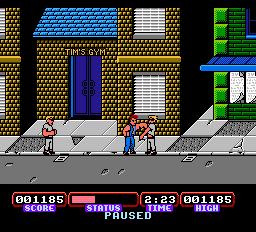
Synopsis:
"Don't
forget the struggle..."
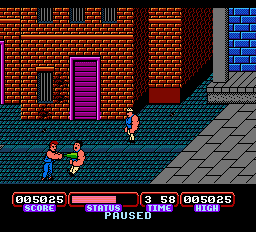
Synopsis:
Smash
popcorn-muscle with vengeance.
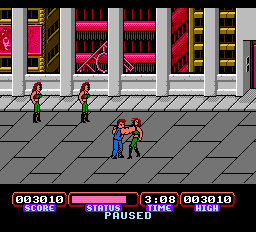
Synopsis:
Still
as difficult as before.
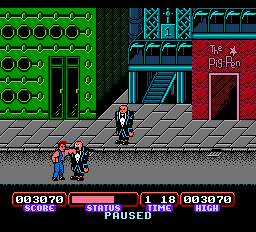
Synopsis:
Bouncer
beatdown!
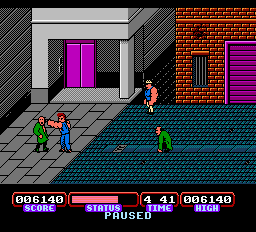
Synopsis:
Punch
Merv the Perv in the face.

Chapter:
Never Short On Enemies
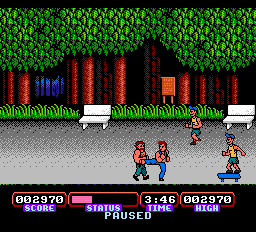
Synopsis:
Park
stages bring out the worst in us.
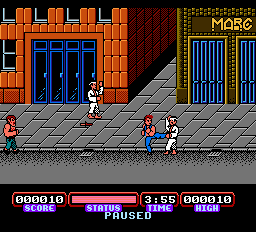
Synopsis:
Send
Williams back in a bodybag.
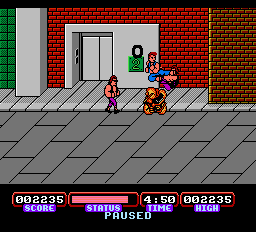
Synopsis:
Jump-kick
that arrogant pig Meatloaf.
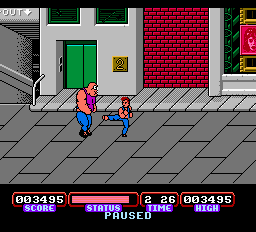
Synopsis:
"...don't
forget the streets.".
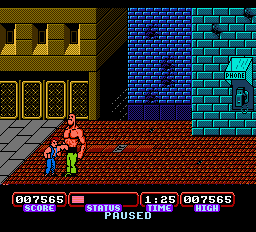
Synopsis:
Tommy
Chong royalties?.
However, what really makes the game so hard is that Taito changed the formula from the first game and made it more like Double Dragon. The promotional art for Target: Renegade depicts an absolutely furious-looking Bruce Lee dude, but the in-game hero depicts something totally different. From head to toe, there's no denying the hero looks like Billy from Double Dragon; the blue vest outfit, eyes, loaf-of-bread hairdo...it's all there. Mr. K from the first game was just a normal dude in khakis and a white shirt trying to get home on the subway, but Jack comes out looking for a fight in baggy pants, an open vest, and a bare chest. Together with his greasy hairdo, the poor guy looks kinda perverted. How come nobody back then wanted to wear shirts under vests? Taboo?
What's more, he even uses Billy's moves! Most of the moves from Renegade were replaced with moves from Double Dragon; no more brutal running clotheslines, crowd-controlling shoulder throwing, devastating knees to the groin, or MMA-style grounding & pounding. Another thing that made the game harder was the inability to kick incoming attackers while being restrained by enemies from behind. These discontinued techniques weren't just useful; they gave the game character and balance while keeping it furiously fun.
The only moves left are token punches, effective gut kicks, staple jump kicks, and the rarely-useful headbutt. Punches still seem useful, and the new sweep/low kick move seems reliable, but the headbutt seems as useless here as in its game of origin. Jump-kicks are still effective againt bikers, but to the dismay of kids everywhere, the motorcycle highway battles are gone. Also absent are the meaningless, highly-annoying, and time-consuming maze parts that plagued the first games final chapter (thank God). Heart power-ups were carried over, but the "P" and "S" ones are gone, so there's no sending enemies straight to the moon this time around.
At first glance, it would seem like the game isn't as visually enticing as its predecessor. Renegade may have better design in some ways, but Target: Renegade actually has more detail and it carries on the crazy facial expressions and standard enemy variety. Enemies in the first game had a plethora of noticeable pain reactions, and Target: Renegade carries that over in spades. Some enemies look like they're truly in pain, and others are so surprised to get their ass-kicked they look like a ghost, while one of the bosses really looks like he's getting hit in the nuts. Even if you don't like the game, it might be worth it to conquer it just to see all the crazy faces enemies make. What Target: Renegade really carried over from the first game was enemy variety.
Though standard in its approach, you fight a bigger collection of assholes in Target: Renegade than in Renegade. It's like they went and got every type of asshole from every type of background and put them all in one game. Renegade put you up against scumbag hippies, motorcycle gangs, and greasers. You even fought hookers! Thankfully, some of that charm in enemy variety is back in Target: Renegade. There's more enemy variety, and the bosses are a lot bigger. Together with Double Dragon clones, you go up against all osrts of rejects; slack-jawed skaters, popcorn-muscle Tylers, knuckle-dragging shortstacks, Merv the Pervs, Amazon bitches...you name it. Those familiar with the genre also may notice Williams wanna-be enemies in a tree stage straight out of Double Dragon.
There's even celebrity appearances by The Karate Kid, "entertainer" Meatloaf, and what looks like closet body-builder Tommy Chong! To me, being able to kick that arrogant shitbag "entertainer/legend/master" Meatloaf off a motorcycle has always been one of the game's strong points. Come to think of it, most of the enemies in this game really make you want to kick their asses, which can work as a driving factor in conquering it. Surprisingly, endboss Mr. Big is nowhere near as strong as endbosses synonimous with the era, and actually seems weaker than all of his henchmen! Some of the regular enemies are actually harder to fight than Mr. Big, and the bosses before him are definitely tougher to defeat.

Target: Renegade definitely deserves praise for pushing so many enemies on the screen; you see up to 5 characters on the screen at any given time duking it out! It may not seem like much now, but back then it was a feat. Such a feat is not accomplished without flicker, however, but that was common in the 8-Bit era. To me, flicker doesn't detract from what the game delivers. What the game does is impressive, especially when we look at some games now that struggle to push more than a few enemies on the screen at the same time. Some may argue its graphical pedigree, but hey, a feat is a feat!
TR aims to give you more of what the first game delivered, and that's not such a bad thing; lots of fights in seedy locales, inhabitated by seedy dudes, led by seedy bosses. No more, no less. It doesn't really try to do anything new, and that's fine. No new first-person stages, no target-practice attempts, and no racing parts. This is a straight-up brawler. Anyone into brawlers like we are can enjoy this game, for better or for worse. Those who seek tough titles may really enjoy this game. It's arguably one of the most challenging, time-consuming games in the genre, ever. Own Renegade and Target: Renegade. If not for completion, then at least for contrasting and comparing the two. Taito no longer makes these types of games, so now we can go back and look deeper into them.
The point is, this 8-Bit, seemingly trivial game with undesirable reception is tied to those memories. Sure, it may not have been the best now or then, but the fact that I could look forward to anything (even this game) back then meant something. I had lost hope at a young, single-digit age, and even if they weren't the best, there are games like this (and Wrath of the Black Manta) that gave me something to live for.
Chapter:
Bad Memories And Good Times
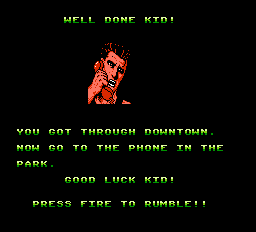
Synopsis:
What's
a collect call?
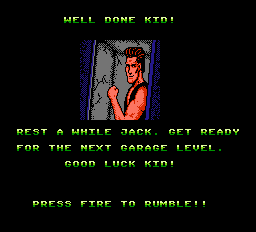
Synopsis:
Bare
chest under a vest R&B singer?
